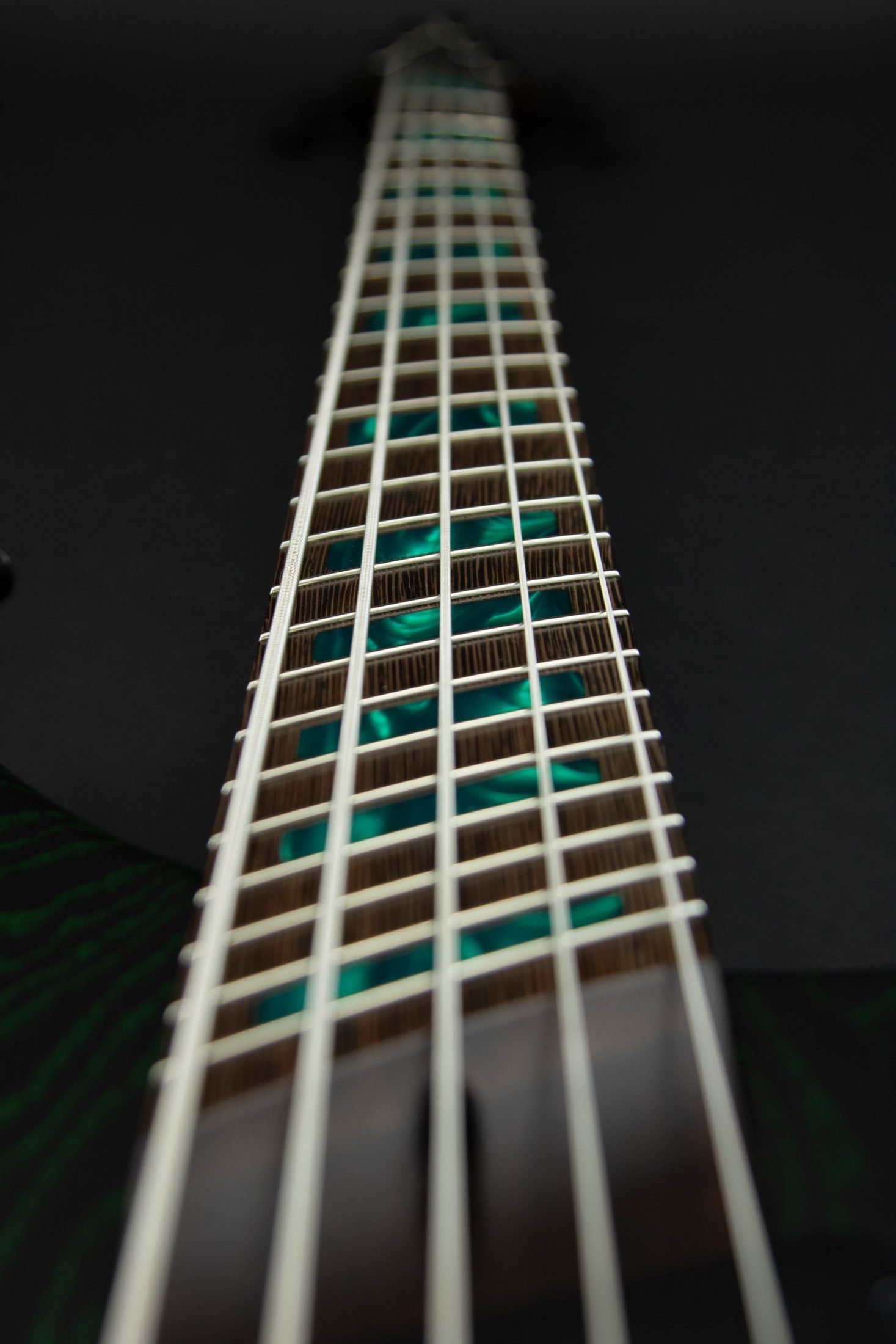T i p p i n g
T h e
S c a l e s
By: Jamie Gale
Curator | Boutique Guitar Showcase
In recent years, we have seen more and more guitar players using multi-scale guitars, colloquially known as fanned frets, a term that I’m on a mission to abolish…more about that later.
I’ve been aware of these fanned frets for many years. Thinking they were about ergonomics, which as a young man I was not particularly concerned about. I may never have an issue performing with a traditionally fretted guitar, so why bother? That’s only a problem for a few unfortunate folks right? I’m not hurting, so goodbye fanned frets, maybe I’ll see you later When I’m Sixty Four…but hopefully not.
Some years later I began to hear a different description, Multi-scale. This term refers to each of the strings on a guitar being given its own scale length, for purposes of maintaining even string tension and tone across all strings. It also improves intonation. Ergonomics are indeed improved, but I believe this is an unintended consequence. It is not the purpose or impetus of the multi-scale design’s origin.
The theory of stringed instruments suggests that there is an ideal length and diameter of string for a given tonal range. Simply imagine the inside of a piano. The strings for the low notes are thicker and longer than those for the high notes. If you look at the strings within a symphony orchestra, the violin is smaller (scale length) with thinner strings than that of the viola, as follows the cello, then contra bass.
If this theory is true on a larger scale, over multiple instruments, then even on a micro scale each string would benefit from its own ideal scale length.
Now let’s apply this to a four stringed Bass guitar, imagining each string to represent a different stringed instrument. Instead of a G string, a violin. The D is a viola, A the cello and E the contra bass or double bass as it’s commonly known. Viola! We have a new ideal scale length representation for each string.
This idea of multi-scale made a lot more sense to me. But now we have a problem… If this is a functional improvement, with empirical evidence…why do we still make the less functional guitars? You know, the ones with the inferior nut, saddle and fret positions that are parallel to each other…the guitar as we know it.
“Between two products equal in price, function and quality, the better looking will outsell the other.” - Raymond Loewy
Equal in price, function and quality. If they do not measure up as equal in these three areas, we never make it to better looking, the fourth criteria. Multi-scale guitars out function single scale guitars. They are not equal.
However, multi-scale guitars do not outsell their inferior parallel fret competition. Why?
A few things to consider. Firstly, innovation is time consuming and expensive. As a result, innovative products are usually more expensive than the existing, more established competition. So they are not equal in price, which is one of Loewy’s four determining factors. It takes time for demand to rise to the point of attracting competition, which in turn leads to economies of scale. Most multi-scale guitar makers still have to make their own hardware and pickups to match their new designs. A very costly endeavour. In contrast, if you make a traditional parallel fret guitar, you have thousands of pickup and hardware options, with varying degrees of quality, function, price and style. Making traditional guitars much cheaper to make.
Let’s look at a familiar, not so distant historical example for a moment. The Compact Disc, AKA the CD.
When the first consumer release of the compact disk players hit the market in 1982, they sold for $1,000 USD. That’s $2,800 USD in today’s economy. As I sit and write this article (Nov 2021), I can buy a CD player on Amazon for $30 USD, which is equivalent to only $10.55 USD in 1982. Approximately 1% of the original. A 99% discount. In retrospect that seems insane!
Multi-scale guitars have existed already for many decades in the boutique guitar market, with long standing believers like Dingwall and Greenfield, and a growing list of custom guitar makers who will truly customize almost any desire you can conceive. This incidentally takes care of Loewy’s fourth criteria, “quality”. You’ll be hard pressed to out-quality makers like Greenfield and Dingwall. But back to price. It is only recently that large scale manufacturers like Ibanez, ESP, Eastman and Cordoba are offering more budget friendly multi-scale guitars. Though most offerings are still well above $1,000 USD. Alternatively, you can buy any number of parallel fret guitars starting as low as $100 USD. The result is that most people buying their very first guitar will choose a parallel fret guitar simply based on economics, until there are equally priced multi-scale guitars to choose from.
With modern guitar hero’s from Tosin Abasi and Andy McKee, to Adam “Nolly” Getgood. As well as a substantial increase in guitar manufacturers who are offering more and more multi-scale options, at ever decreasing prices. There is a strong case that the future of multi-scale guitars. But will it ever over take the less functional parallel fret? If Raymond Loewy is right about “two products equal in price, function and quality”, it’s only a matter of time until the Multi-scales tip in their favour, and the parallel fret slides off into antiquity.

